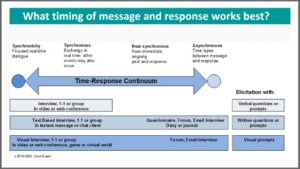
In the second webinar of our series focused on the impact that the COVID-19 crisis has on researchers, When the Field is Online, Dr. Janet Salmons, free-range scholar, Methods Guru for Sage Publications’ Methodspace and long-time practitioner and teacher of online research discussed ways researchers can adapt their methods using online research.
Janet was an early adopter of e-learning and worked with doctoral students online. This early work led her to think about how these technologies could support research as well. Two of Janet’s books – Cases on Online Interview Research and Designing Online Qualitative Studies are available in Sage Methods database where individual chapters can be downloaded as PDF files.
>> View Dr. Salmons' webinar now
A Changing Landscape For Research
COVID-19 has meant that most of us are under ‘stay-at-home’ orders and are unable to conduct any planned fieldwork that involves face-to-face contact with participants. So we have to either delay or adapt our research. Janet points out that research design is a holistic process and any change in any area of the study is going to have an impact on some other part of your design or approach. In the webinar, she focused on ways you can adapt elicited data collection techniques where the researcher interacts with participants.
She categorized online communication tools into four types:
- Text-based tools where communication is done through typed words
- Video conference tools where audio, video and share applications can be used
- Social media or online communities where communication is done through posts and responses
- Games or immersive environments where communication is done through audio, text or visual exchange where you can use roles and game play
If you are going to adapt your face-to-face study, you need to think through how and why you would use technology. The answer will influence both what tool you will use and who the participants might be.
There are several reasons why you might use online tools:
- Using online tools as a medium for data collection because you can’t meet face-to-face.
- Or using online tools or platforms as settings for data collection as they have some features we want to use – e.g. if we want to see the participants, we would use a visual medium such as videoconferencing.
- Or studying the technology as a phenomenon. For example, you may be interested in how people use the technology – what kind of materials they post and with what frequency
Another factor is the time response continuum from synchronicity to asynchronous. See the figure below:

Synchronicity is when you and the participant are focused on one task in real time. Synchronous communication is same time exchange but may be combined with other activities not related to the research – the participant might be dipping into other conversations on or offline, or texting. Near synchronous communication is an elongated conversation. Finally, asynchronous communication is where there is a time lapse between the message and the response. The chart above indicates different types of online methods and the lapse between the message and response. You need to consider which time-response works best for your study as well as for your participants.
Cultivate Your Relationship With Participants
Another crucial consideration is how will we relate to people online? How will we build a relationship? Are you a miner (someone who digs out data), a gardener (someone someone who needs time to cultivate trust and rapport) or a traveller (a researcher who journeys with the participant)? Whatever approach you take, you need to allow time to engage with participants.
You also need to consider which aspects of a face to face encounter you want to retain in an online space, such as - eye contact, setting, emotions, or pauses. You need to think through how you’ll communicate visually.
A video conference call is the closest equivalent to a face-to-face interview. However, you need to consider whether your participants have a webcam and whether they are willing to participate where you can not only see them but be part of their home environment.
A text chat approach is another option. It can be done with a phone. A discussion forum is another text approach. Email is a text-based approach that shouldn’t be dismissed. It gives the participant time to reflect on their answer. Janet offered an important tip if you are using text-based approaches. Break down your questions into tiny chunks. It is important to keep your participants engaged and keep the exchange going. You don’t want them to give up while trying to respond to a long, complicated question.
Watch the webinar to learn more from Janet Salmons on how you can adapt your face-to-face data collection methods with online approaches. Janet is continuing to answer the over 180 questions posed during the webinar in Methodspace under the tag -
burning.
You can continue the conversation in Twitter using the hashtag
#NVivoChat
ABOUT DR. SALMONS

Janet Salmons, PhD
Dr. Salmons is independent researcher, writer, instructor, consultant, and contributor to
Sage Publications’ Methodspace. Her eclectic, interdisciplinary interests include collaboration, leadership, creativity, sustainability, and ethics in a digital world.
